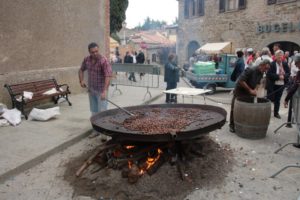
Il paese si trova a 734 metri sopra il livello del mare, lungo la strada che porta al Monte Amiata, all’ingresso della riserva naturale di Poggio all’Olmo. L’area collinare in cui è situato segna il passaggio definitivo dalla valle dell’Ombrone al massiccio del Monte Amiata. Monticello Amiata dista circa 50 chilometri da Grosseto e poco più di 9 chilometri dal capoluogo.
Oggi non rimane nulla dell’antico borgo altomedievale, completamente distrutto da un incendio nel 1240. Il nuovo villaggio fu ricostruito dagli abitanti di Montepinzutolo con il nome di Monticello e nel 1261 divenne un comune indipendente. Dopo le prime mura cittadine dell’XI secolo, altre sono state costruite e sono rimaste pressoché intatte fino ad oggi, anche se in alcuni punti è venuto a saldarsi con case ed edifici costruiti a contatto con la fortificazione. Il paese è accessibile attraverso le due porte, che si aprono rispettivamente nella parte occidentale (Porta Grossetana) e nella parte orientale (Porta Senese) delle mura. All’inizio del XIV secolo fu posta sotto la protezione di Siena e nel 1348, a causa dell’insubordinazione riguardante il doppio pagamento delle tasse all’abbazia di San Salvatore e Siena, ricevette una scomunica che, curiosamente, non è mai stata ritirata formalmente fino ad oggi. Fu annessa al Granducato di Toscana nella metà del XVI secolo, nel 1783. Il municipio è situato nella centralissima Via Grande e risale al XVII secolo. Era la sede del comune di Monticello Amiata. Sopra il portale bugnato si trova lo stemma degli Aldobrandeschi. Quando nel 1783 il Granduca Leopoldo sancì il trasferimento della sede municipale di Cinigiano, l’edificio divenne sede della corte fino al 1837. Oggi ospita l’interessante Museo della Casa, una ricostruzione della realtà rurale del diciannovesimo secolo.
Oggi il paese è principalmente meta di turismo estivo, interessato alle ricchezze naturalistiche presenti nel territorio, come la “strada delle fontane” e la “via delle castagne”. La strada delle fontane costituisce un itinerario storico-ambientale intorno al paese di Monticello Amiata, discendente verso le fonti d’acqua conosciute con il nome di Fonte Vecchia e Fonte di Sotto, utilizzate in passato come annaffiature per animali e per uso domestico. . Il percorso del castagno è un percorso naturalistico che si inoltra nel bosco sottostante il paese per raggiungere una vasta area di castagni: l’itinerario è inoltre caratterizzato da elementi antropologici, grazie alla presenza di essiccatoi, capanne e muretti a secco.
LUOGHI DI INTERESSE (PLACES OF INTEREST)
- Chiesa di San Michele Arcangelo
- Santuario della Madonna di Val di Prata
- Cappella della Madonna del Lampino

The village is located at 734 metres above the sea level, along the road that leads to Mount Amiata at the entrance to the Poggio all’Olmo natural reserve. The hilly area in which it is located marks the definitive passage from the Ombrone valley to the Monte Amiata massif. Monticello Amiata is about 50 kilometres from Grosseto and just over 9 kilometres from the municipal capital.
Today nothing remains of the ancient high-medieval village, which was completely destroyed by a fire in 1240. The new village was rebuilt by the inhabitants of Montepinzutolo with the name of Monticello, and in 1261 it became an independent municipality. After the first city walls of the 11th century, others were built and they have remained almost intact until today, although in some places it has come to weld itself with houses and buildings built in contact with the fortification. The village can be accessed through the two gates, which open respectively in the western part (Porta Grossetana) and in the eastern part (Porta Senese) of the walls. At the beginning of the 14th century it was placed under the protection of Siena and in 1348, due to insubordination regarding the double payment of taxes to the abbey of San Salvatore and Siena, it received an excommunication which, curiously, has never been formally withdrawn until today. It was annexed to the Grand Duchy of Tuscany in the mid-sixteenth century, in 1783. The town hall is located in the central Via Grande and dates back to the seventeenth century. It was the seat of the municipality of Monticello Amiata. Above the rusticated portal there is the Aldobrandeschi coat of arms. When in 1783, the Grand Duke Leopold II sanctioned the transfer of the municipal seat in Cinigiano, the building became the seat of the court until 1837. Today it houses the interesting House Museum, a reconstruction of the rural reality of the nineteenth century.
Today the village is mainly a destination for summer tourism, interested in the naturalistic riches present in the territory, such as the ” fountains route” and the ” chestnut route”. The road of the fountains constitutes a historical-environmental itinerary around the village of Monticello Amiata, descending towards the water sources known under the names of Fonte Vecchia and Fonte di Sotto, used in the past as watering for animals and for supplies for domestic use. The chestnut route is a naturalistic route that goes into the woods below the village to reach a vast area of chestnut trees: the itinerary is also characterized by anthropological elements, thanks to the presence of dryers, huts and dry walls .

